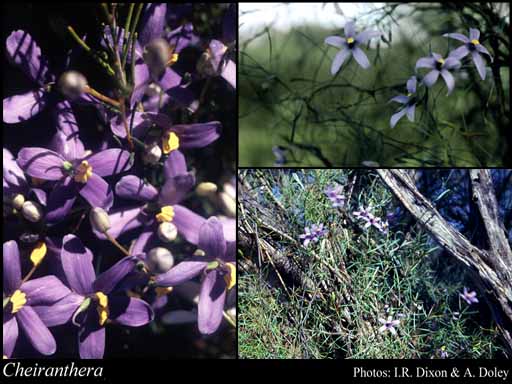- Reference
- Edwards's Bot.Reg. 20: subtab. 1719 (1834)
- Name Status
- Current

Scientific Description
Common name. Handflowers. Family Pittosporaceae.
Habit and leaf form. Shrubs, or lianas. Plants unarmed. To 0.5–1 m high. Self supporting, or climbing; stem twiners. Not heterophyllous. Leaves small, or medium-sized; alternate; petiolate, or sessile; simple. Leaf blades dorsiventral; entire; linear, or ovate. Leaf blade margins entire, or serrate; involute.
Reproductive type, pollination. Fertile flowers hermaphrodite. Unisexual flowers absent. Plants hermaphrodite.
Inflorescence and flower features. Flowers solitary, or aggregated in ‘inflorescences’. Inflorescence few-flowered, or many-flowered. Flowers in racemes, or in corymbs. Inflorescences terminal, or axillary. Flowers pedicellate; bracteate; small; very irregular; asymmetric. The floral asymmetry involving the androecium. Flowers 5 merous; tetracyclic. Perianth with distinct calyx and corolla; 10; 2 -whorled; isomerous. Calyx present; 5; 1 -whorled; polysepalous (sometimes cohering at base); exceeded by the corolla. Corolla present; 5; 1 -whorled; polypetalous (rarely cohering at base, petals spreading from the base); imbricate; regular; purple to blue, or green (rarely). Petals ovate, or obovate. Androecium present. Androecial members definite in number. Androecium 5. Androecial members free of the perianth; free of one another. Stamens 5 (turned to one side of the ovary); all more or less similar in shape; isomerous with the perianth. Filaments inverted club-shaped. Anthers all alike; basifixed; dehiscing via pores (2 apical pores); tetrasporangiate. Gynoecium 2 carpelled, or 3 carpelled. The pistil 2–3 celled. Gynoecium syncarpous; eu-syncarpous; superior. Ovary plurilocular; 2 locular, or 3 locular; shortly stipitate. Ovary summit glabrous (or glabrescent). Gynoecium stylate. Styles 1; hairless. Styles bent in bud. Stigmas 1. Placentation parietal. Ovules 30–50 per locule (i.e. ‘many’).
Fruit and seed features. Fruit 12–18 mm long; blue (brown); dehiscent; a capsule (2-valved). Capsules septicidal and loculicidal. Fruit 30–50 seeded (i.e. ‘many’). Seeds compressed (flattened, almost globular).
Geography, cytology, number of species. World distribution: Australia. Native of Australia. Endemic to Australia. Australian states and territories: Western Australia, South Australia, Queensland, New South Wales, Victoria, and Australian Capital Territory. South-West Botanical Province. A genus of 4 species; 2 species in Western Australia; 2 endemic to Western Australia.
Additional comments. Etymology: from Latin chir, hand; antheros, flowery; the 5 stamens are all on one side of the ovary, like the fingers of a hand.
Etymology. From the Greek for "hand" and "flower", referring to their use in bouquets.